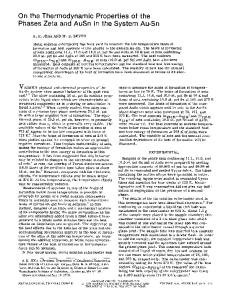Comments on the thermodynamic reassessments of the Ni-Zn system
- PDF / 50,539 Bytes
- 2 Pages / 612 x 792 pts (letter) Page_size
- 71 Downloads / 417 Views
Short Communications
Comments on the Thermodynamic Reassessments of the Ni- Zn System G.P. Vassilev, University of Sofia
The first full thermodynamic assessment of the Ni-Zn system has been done by Vassilev [1992Vas]. In that work all phases were treated as substitutional solid solutions, due to the limitations imposed by the software. Later, Vassilev et al. [2000Vas] performed a thermodynamic optimization of the Ni-Zn system using the software package BINGSS. In latter work, the liquid phase and the binary Ni-based solid solutions were treated as disordered substitutional phases. For the intermediate compounds:  (B2-type), 1 (AuCu-type), and ␥ (␥brass), having large homogeneity intervals, models available in the literature for phases with substitutional defects and vacancies were applied. The ␦-phase (Ni2Zn15 [1932Hei] or Ni3Zn22 [1935Tam], with supposed narrow homogeneity interval) was treated as stoichiometric compound NiZn8. For the equiatomic phases, satisfactory optimizations were achieved with both models—with and without vacancies [2000Vas]. Nevertheless, the first one was finally preferred due to better fitting of the S-like shape of the zinc chemical potential with inflection point around the equiatomic concentration. In a later optimization Su et al. [2002Su], using the THERMOCALC software package, applied models without vacancies for , 1, and ␥ phases, whereas ␦-phase was treated as Ni2Zn15. They stated the reason for not using models with vacancies was “the percent vacancy concentration in any metallic material at its melting point is less than 10−3” [2002Su]. Such a statement seems to be somewhat simplifying for a complex problem. In fact, the presence of non-
negligible amounts of vacancies (structural and thermal) is largely recognized and experimentally revealed in many intermediate phases exhibiting the above-mentioned structures [1963Mel,1969Mal,1974Ana,1980Arn, 1981Pea, 1995Ans,2001Hil]. Especially, for the Ni-Zn compounds, Anantatmula and Masson [1974Ana] underlined the influence of the vacancies on the thermodynamics of the NiZn ␥-phase. Moreover, Vassilev et al. [2000Vas] have not claimed developing new models and have explicitly cited the literature sources of the models used. From the other side, one realizes that the vacancy-containing models are more complicated and are avoided, usually, in the descriptions of ternary phases. Undoubtedly, simpler approaches are more practical from the viewpoint of the creation of thermodynamic databases for multicomponent systems, but one should be aware that the negligence of the vacancies is often a simplification. Recently, the Ni-Zn system has been reoptimized by Miettinen [2003Mie] and by Jiang et al. [2005Jia] (both using THERMOCALC) to achieve thermodynamic descriptions of the CuNi-Zn system. Miettinen [2003Mie] makes a graphical comparison between experimental data and the results of Vassilev et al. [2000Vas] and Su et al. [2002Su] to justify his choice. In both reassessments (Miettinen [2003Mie] Jiang et al. [2005Jia]) the parameters derive
Data Loading...











